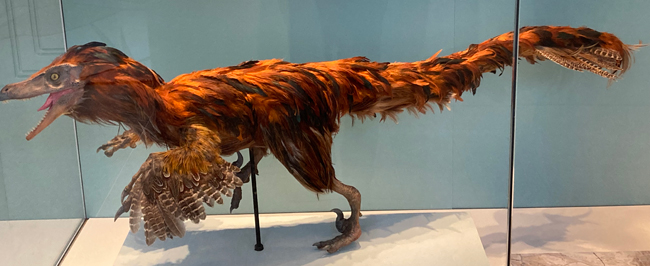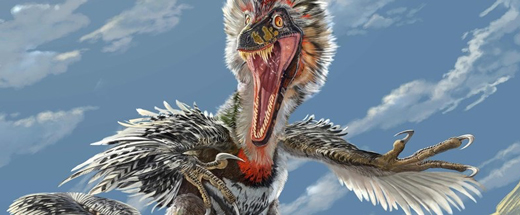Researchers including scientists from University College Cork (Ireland) have demonstrated that fossil feather proteins can persist over deep time. Using sophisticated and highly sensitive X-ray techniques the team have clarified the chemical composition of feathers preserved in the fossil record.

Picture credit: Everything Dinosaur
Identifying Fossil Feather Proteins
The study, published in “Nature Ecology and Evolution” provides a new perspective on feather evolution. Earlier research had suggested that primitive feathers had a different chemical composition to that of the feathers of extant birds. The new research reveals that the protein composition of modern-day feathers was also present in the feathers of dinosaurs and enantiornithine birds. The researchers conclude that the chemistry of feathers originated much earlier than previously thought.
The study was led by Dr Tiffany Slater and Professor Maria McNamara (School of Biological, Earth, and Environmental Science, University College Cork). They worked in collaboration with scientists at Linyi University (China) and the Stanford Synchrotron Radiation Lightsource in the USA.
The feathers of the Early Cretaceous dromaeosaurid Sinornithosaurus were analysed. In addition, the integumentary covering of the enantiornithine Confuciusornis was studied.

Commenting upon the implications of their study, Dr Slater said:
“It’s really exciting to discover new similarities between dinosaurs and birds. To do this, we developed a new method to detect traces of ancient feather proteins. Using X-rays and infrared light we found that feathers from the dinosaur Sinornithosaurus contained lots of beta-proteins, just like feathers of birds today.”
Fossilised Proteins
Fossil proteins are valuable tools in evolutionary biology. Recent technological advances and better integration of experimental methods have confirmed the feasibility of biomolecular preservation in deep time, yielding new insights into the timing of key vertebrate evolutionary transitions.
Keratins (formerly α-keratins) and corneous β-proteins (CBPs, formerly β-keratins) are of particular interest to palaeontologists. These proteins define tissue structures that underpin fundamental physiological and ecological strategies and can provide evidence to help map how feathers evolved.
As well as using infrared and sulphur X-ray spectroscopy to plot chemical signals, the team also conducted taphonomic experiments to help them to understand how feather proteins break down during fossilisation.
Dr Slater explained:
“Modern bird feathers are rich in beta-proteins that help strengthen feathers for flight. Previous tests on dinosaur feathers, though, found mostly alpha-proteins. Our experiments can now explain this weird chemistry as the result of protein degradation during the fossilisation process. So, although some fossil feathers do preserve traces of the original beta-proteins, other fossil feathers are damaged and tell us a false narrative about feather evolution.”

Picture credit: Everything Dinosaur
The image above shows a Confuciusornis model from the PNSO range.
To view this collection: PNSO Age of Dinosaurs Models.
Surviving the Fossilisation Process
This study confirms that fossil feather proteins can survive fossilisation, that these proteins can persist through deep time.
Senior author of the study, Professor Maria McNamara (University College Cork) commented:
“Traces of ancient biomolecules can clearly survive for millions of years, but you can’t read the fossil record literally because even seemingly well-preserved fossil tissues have been cooked and squashed during fossilisation. We’re developing new tools to understand what happens during fossilisation and unlock the chemical secrets of fossils. This will give us exciting new insights into the evolution of important tissues and their biomolecules.”
As predicted by the experiments conducted by this study, analyses of Mesozoic feathers confirm that evidence of feather corneous β-proteins (CBPs) can persist through deep time.
Everything Dinosaur acknowledges the assistance of a media release from University College Cork in the compilation of this article.
The scientific paper: “Preservation of corneous β-proteins in Mesozoic feathers” by Tiffany S. Slater, Nicholas P. Edwards, Samuel M. Webb, Fucheng Zhang and Maria E. McNamara published in Nature Ecology and Evolution.
Visit the Everything Dinosaur website: Everything Dinosaur.






Leave A Comment